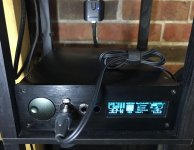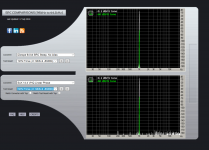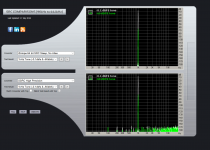 This thread has been split off from this thread Reference DAC Module - Discrete R-2R Sign Magnitude 24 bit 384 Khz
This thread has been split off from this thread Reference DAC Module - Discrete R-2R Sign Magnitude 24 bit 384 Khz 
Got the resampler to work, pretty user friendly and the graphs are very useful. Still not sure if it's better than FPGA 2k/4k taps implementation. Caution: the ability to run Amanero at its full 384khz capacity may produce an overwhelming sense of power
My corrupted psychology tells me the sound is much much smoother. Perfection
Last edited by a moderator:
Great, you did it. And yes, much smoother even when I didn't upsample at the beginning. Especially the high freq are far more natural to my ears.
And I am thinking about what music next
The good news for Soeren is that the bottleneck is not so much the hardware. OK, still a little
And I am thinking about what music next
The good news for Soeren is that the bottleneck is not so much the hardware. OK, still a little
Great, you did it. And yes, much smoother even when I didn't upsample at the beginning. Especially the high freq are far more natural to my ears.
And I am thinking about what music next
The good news for Soeren is that the bottleneck is not so much the hardware. OK, still a little
Uses 1-2% CPU. The smoothness is probably not imagined... and the highs are still there. I would prefer to see at least an attempt at a theoretical explanation before I settle on it though... This is certainly something nice to try for those of us using USB, not so perfect for the SPDIF folks....
Attachments
Last edited:
And how many taps did it calculate on?
//
I don't know what we have but we should do 1 million taps just to beat Chord Dave, once and for all
Link to default SSRC algo project page: Shibatch's Software Repository The project lead is a computer science professor in Japan.
Based on how little information I was able to find with simple google searches it's possible that it's still an area not fully developed. After all not that many people who want to oversample have DACs that offer NOS.
Last edited:
Is this in any way similar to the PCM > DSD craze, or is it completely different? Cause the fake dsd was also smooth but sucked in so many other ways
Not sure about DSD, but it is a fact that longer FIR filters perform better. I have no problem believing that the differences are audible.
I sent Professor Shibata an email asking for more details. Maybe we'll even get a response!
Last edited:
Found this (see photo). It's likely that SoX supports up to 1 million taps. But I can't find the option in foobar, and Audionirvana user screenshots suggest they max out at 500k taps. Very promising.
Edit: 1 million taps probably has to do with Izotope more. Here's another link: PCM->DSD128 conversion in A+ = amazing SQ improvement - Integrateds - PS Audio
Edit: 1 million taps probably has to do with Izotope more. Here's another link: PCM->DSD128 conversion in A+ = amazing SQ improvement - Integrateds - PS Audio
Attachments
SRC online comparator shows Izotope 64bit to be superior. Time to abandon foobar2k?...
SRC Comparisons
SRC Comparisons
Attachments
That's only for downsampling from 96 to 44.1
We're upsampling x4 or x8
you don't think there's a correlation?... At least Izotope supports >1 million taps. That sounds like a definitive plus to me.
Thanks for bringing up the topic of software resamplers.. the sound is so much better to my ears... Might even give androa a fighting chance against totaldac
Last edited:
Soren, can you still comment on Paul's original simulation setup and whether it agrees with the rev.4/5 boards to your knowledge? If so, I think those of us with extreme capacitance on the vrefs might try to replace the 0.1R resistor with 0.01R for the theoretical benefits and potential audible improvements.
Here's the link again for your convenience:
Vref musings: the final frontier? | moreDAMfilters
Woolly Boomboxes: a spotters guide to break-dancing mammoths* | moreDAMfilters
Also I found 0.008R 0603 resistors too. Is there a chance Paul was right that it would help even further? Based on Paul's simulations it would contribute to a more uniform ripple by larger than what the 20th bit would be.
Here's the link again for your convenience:
Vref musings: the final frontier? | moreDAMfilters
Woolly Boomboxes: a spotters guide to break-dancing mammoths* | moreDAMfilters
Also I found 0.008R 0603 resistors too. Is there a chance Paul was right that it would help even further? Based on Paul's simulations it would contribute to a more uniform ripple by larger than what the 20th bit would be.
Last edited:
SRC online comparator shows Izotope 64bit to be superior. Time to abandon foobar2k?...
That's far below the noisefloor and the hearing threshold - doesn't matter.
That's far below the noisefloor and the hearing threshold - doesn't matter.
There are other parameters too. In any case, how else should we explain the SQ gain when we switched from internal filter to resampler-v linear filter? I'm guessing it's the benefits that increased filter length offers.
It's likely that SSRC uses 500k taps just like the max of SoX. In comparison, partypak uses 2k taps, and latest firmware supports 4k. Chord Dave uses 160k taps and it was a major major selling point. There are reports of audible gains all over the internet in comparisons between 500 and 2k taps for example.
Can you try the resampler? I think it's probably theoretically sound.
Quick note to anyone who wants to try "software" oversampling. Install the plugin in the attachment, go to Fb2k DSP, add resampler-V, use default resampling options, add frequency mappings as needed, e.g. 44.1,88.2,176.4->352.8, 48,96,192->384. You also need to activate NOS filter on the dam1021 to bypass FPGA FIR1 oversampling. Upload the partypak in the attachment to your dam dac, power cycle and select bank 4 (soft) which is the NewNOS filter. If you're using a control unit like ArDAM or SK Lite, then the displayed sample rate should be either 352.8 or 384Khz. 
Attachments
Soren, can you still comment on Paul's original simulation setup and whether it agrees with the rev.4/5 boards to your knowledge? If so, I think those of us with extreme capacitance on the vrefs might try to replace the 0.1R resistor with 0.01R for the theoretical benefits and potential audible improvements.
Here's the link again for your convenience:
Vref musings: the final frontier? | moreDAMfilters
Woolly Boomboxes: a spotters guide to break-dancing mammoths* | moreDAMfilters
Also I found 0.008R 0603 resistors too. Is there a chance Paul was right that it would help even further? Based on Paul's simulations it would contribute to a more uniform ripple by larger than what the 20th bit would be.
Sorry, I don't really track what other people do, and don't intent to use time looking into it.... I can say that on my latest products I use copper traces designed for R010 to R025 resistance, depending on product. You need to match capacitance carefully to low impedances, so do your simulations....
Last edited:
Sorry, I don't really track what other people do, and don't intent to use time looking into it....
But it's aimed at improving your product! Please?...
There are other parameters too. In any case, how else should we explain the SQ gain when we switched from internal filter to resampler-v linear filter? I'm guessing it's the benefits that increased filter length offers.
It's likely that SSRC uses 500k taps just like the max of SoX. In comparison, partypak uses 2k taps, and latest firmware supports 4k. Chord Dave uses 160k taps and it was a major major selling point. There are reports of audible gains all over the internet in comparisons between 500 and 2k taps for example.
Can you try the resampler? I think it's probably theoretically sound.
I think it it's a question of time domain, frequency domain, phase, harmonic distortion, aliasing, spuria and noise in general. The difference in filter type is audible at very low levels.
I looked at and listened to impulse responses (single sample) generated by the DAM1021 with different filters and recorded with my Prism AD-2 converter. These impulses look and sound very different from each other. For some reason the Prism converter doesn't seem to suffer from pre-ringing while also being free of aliasing and noteable phase deviations within the audio band at 44,1 khz. It cuts off most of the signal above 19.5 khz though.
I use S/PDIF (or rather AES/EBU), so no way to run the converter at 384 khz. I need it to work at its best at 44,1 khz or 96khz max anyway for studio use (currently building a 32-channel unit).
Again, I think the DAM1021 sounds pretty good with the added VREF caps and using the latest "soft" filter. The high end may sound a little clogged, but there is nothing iritating in the signal and the dynamics are great.
I think it it's a question of time domain, frequency domain, phase, harmonic distortion, aliasing, spuria and noise in general. The difference in filter type is audible at very low levels.
I looked at and listened to impulse responses (single sample) generated by the DAM1021 with different filters and recorded with my Prism AD-2 converter. These impulses look and sound very different from each other. For some reason the Prism converter doesn't seem to suffer from pre-ringing while also being free of aliasing and noteable phase deviations within the audio band at 44,1 khz. It cuts off most of the signal above 19.5 khz though.
I use S/PDIF (or rather AES/EBU), so no way to run the converter at 384 khz. I need it to work at its best at 44,1 khz or 96khz max anyway for studio use (currently building a 32-channel unit).
Again, I think the DAM1021 sounds pretty good with the added VREF caps and using the latest "soft" filter. The high end may sound a little clogged, but there is nothing iritating in the signal and the dynamics are great.
Thanks for the great explanation! Explorations like these are made possible by people like you who bring in lots of outside knowledge. 44.1Khz/96Khz benefits from software upsampling too. Maybe try upsampling to 192khz in software, there could still be a noticeable benefit. And if you have a USB interface lying around I would urge you to try it for yourself. I believe there is a huge difference and it's probably due to the more correct and perfect filter.
If TotalDac is supposed to be the most natural and musical, this would be a huge step in that direction. Don't take my word for it, look at the theoretical improvements. I don't believe there is more distortion added by using software oversampling.
I recall Soren mentioning that the 6moon reviewers really loved the DSD mode in the lampanizer atlantic (which uses dual-mono dam1021). The removal of FIR1 oversampling artifacts might be the common cause here.
Last edited:
- Status
- This old topic is closed. If you want to reopen this topic, contact a moderator using the "Report Post" button.
- Home
- Source & Line
- Digital Line Level
- Musings on soekris Reference Dac Module



